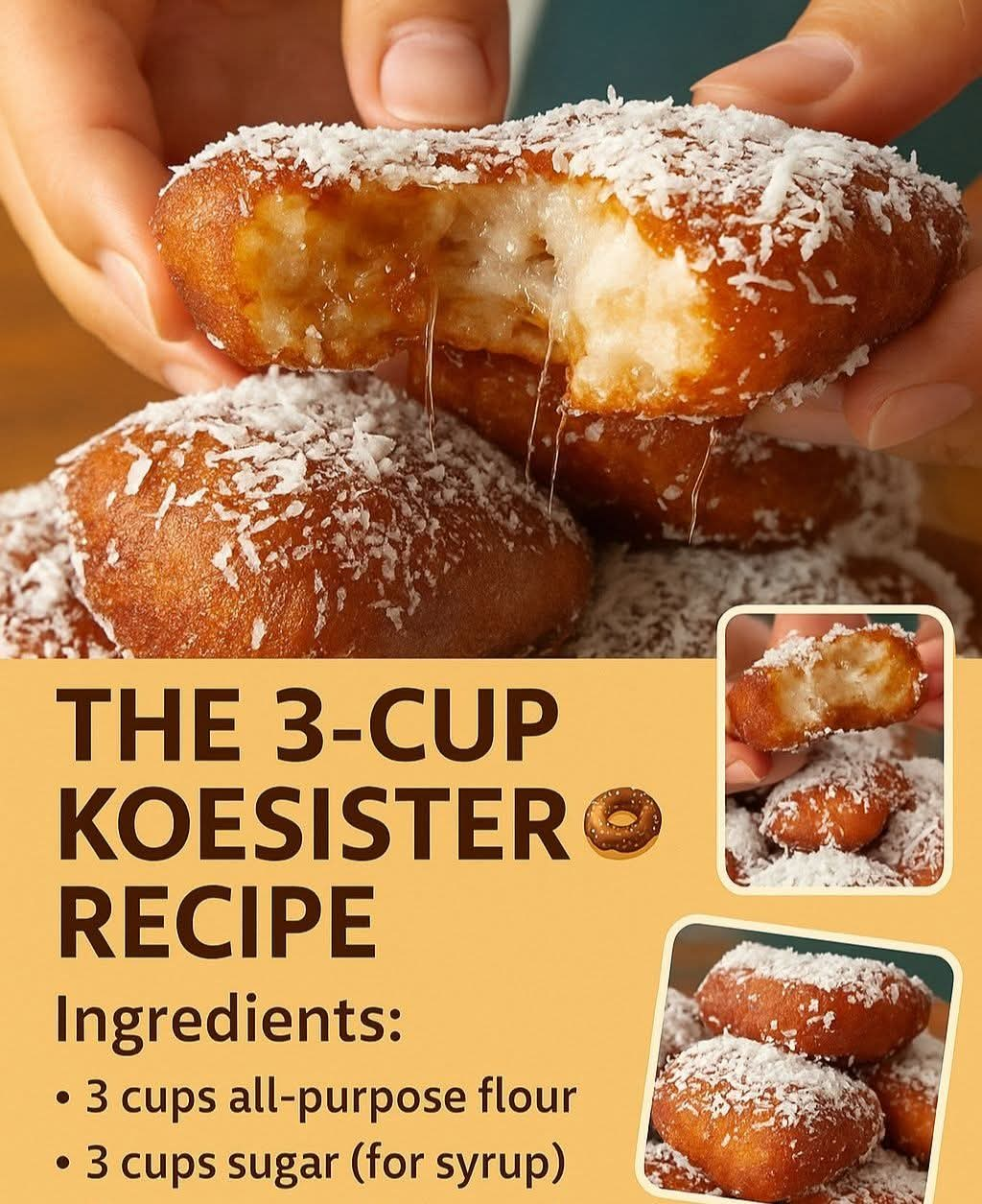Absolutely! Here’s a complete and rich version of the 3-Cup Koesister Recipe — packed with history, method, ingredients, preparation, and a flavorful conclusion. 🍩✨
The 3-Cup Koesister Recipe 🍩☕✨
🍽️ Introduction
In the heart of South African cuisine lies a sweet, spiced, syrup-drenched treasure: the Koesister. Unlike its cousin the Koeksister, the Cape Malay Koesister is soft, pillowy, and warmly spiced — often enjoyed with a steaming cup of tea or coffee on a lazy Sunday morning. The “3-Cup” name refers to its delightfully simple syrup: 3 cups of sugar, 3 cups of water, and a whole lot of love.
This recipe blends culture, comfort, and community. Passed down through generations, the Koesister is more than a treat — it’s a symbol of heritage and home.
📜 A Sweet Slice of History
Koesisters originated in the Cape Malay community of South Africa, descended from enslaved people brought from Southeast Asia during the Dutch colonial period. Influenced by Indonesian, Malaysian, and Indian culinary traditions, the Cape Malay people developed a unique cuisine rich in spices, flavor, and soul.
While the Koeksister is a syrupy, braided Afrikaner doughnut, the Cape Malay Koesister is a spongy, fried dumpling infused with cinnamon, cardamom, ginger, and aniseed, soaked in syrup and rolled in coconut. It’s often served during family gatherings or religious celebrations like Eid.
🧂 Ingredients
For the Dough:
- 3 cups all-purpose flour
- 2 tsp instant dry yeast
- ½ tsp salt
- 1 tsp ground cinnamon
- 1 tsp ground ginger
- 1 tsp ground cardamom
- 1 tsp aniseed
- 2 tbsp sugar
- ¾ to 1 cup warm water (adjust as needed)
- ¼ cup lukewarm milk
- 1 tbsp melted butter or vegetable oil
For Frying:
- Vegetable oil for deep frying
For the Syrup (The Famous 3-Cup Syrup):
- 3 cups white sugar
- 3 cups water
- 1 stick cinnamon (optional for aroma)
- 2 tsp rose water or vanilla essence (optional)
For Coating:
- 1 to 2 cups desiccated coconut (fresh or dry)
🥣 Method: Making the Dough
- Activate Yeast (if needed):
If using active dry yeast, mix it with a little warm water and sugar. Let it sit for 5–10 minutes until foamy. - Mix Dry Ingredients:
In a large bowl, combine flour, salt, spices, and sugar. - Add Wet Ingredients:
Mix in the lukewarm milk, warm water (start with ¾ cup), melted butter/oil, and yeast. Stir to form a sticky dough. - Knead:
Knead the dough on a lightly floured surface for 8–10 minutes until smooth and elastic. It should be soft but not too sticky. Add a little more flour or water if needed. - Let it Rise:
Cover the dough with a damp cloth or plastic wrap. Let it rise in a warm place for 1 to 1½ hours, or until doubled in size.
🍩 Method: Shaping & Frying
- Punch Down & Divide:
Punch down the dough and divide it into small balls, about the size of a golf ball. - Shape:
Gently press the balls into an oval or disc shape. They will puff up when fried. - Second Rise:
Place shaped koesisters on a lightly greased tray. Cover and let them rise again for 20–30 minutes. - Fry:
Heat oil in a deep pan to medium heat (170–180°C / 340–350°F). Fry in batches until golden brown on both sides, about 2–3 minutes per side. Drain on paper towels.
🍯 Method: Making the Syrup
- Boil Syrup:
In a saucepan, combine 3 cups sugar and 3 cups water. Add cinnamon stick or rose water if using. Boil until the sugar dissolves completely and the syrup slightly thickens (about 10–15 minutes). - Dip the Koesisters:
While the koesisters are still warm, dip them into the hot syrup for a few seconds, ensuring they are fully soaked. - Roll in Coconut:
Remove from the syrup with a slotted spoon and immediately roll in desiccated coconut.
❤️ Lovers of the Koesister
Koesisters are beloved by people across generations and cultures. Whether enjoyed by grandparents who remember them from childhood or young foodies discovering them anew, these golden gems stir memories and create new ones.
Famous food lovers, chefs, and home cooks alike hold Koesisters close to their hearts. In Cape Town, some families gather every Sunday morning to fry up fresh koesisters and share stories over tea. Some even sell them on the roadside — warm, sticky, and fresh, just like grandma made them.
✨ Conclusion
The 3-Cup Koesister is more than a recipe — it’s a tribute to flavor, family, and faith. With its soft center, spiced aroma, and sweet coconut coat, it reminds us of tradition and the joy of sharing. Whether you’re trying it for the first time or bringing it back to your table, every bite carries warmth and history.
So gather your ingredients, roll up your sleeves, and invite some friends or family over. These koesisters are best served fresh, with laughter and love — and of course, a cup of tea. ☕
Would you like a printable version, PDF, or maybe a poster-style image of this recipe?
